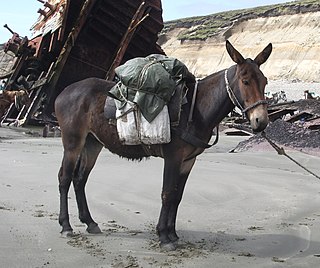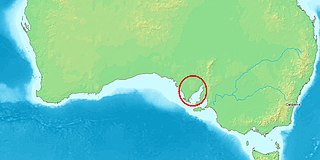Related Research Articles

Theodosius Grygorovych Dobzhansky was a prominent Ukrainian-American geneticist and evolutionary biologist, and a central figure in the field of evolutionary biology for his work in shaping the modern synthesis. Dobzhansky was born in Ukraine, then part of the Russian Empire, and became an immigrant to the United States in 1927, aged 27.

In biology, a hybrid is the offspring resulting from combining the qualities of two organisms of different breeds, varieties, species or genera through sexual reproduction. Hybrids are not always intermediates between their parents, but can show hybrid vigor, sometimes growing larger or taller than either parent. The concept of a hybrid is interpreted differently in animal and plant breeding, where there is interest in the individual parentage. In genetics, attention is focused on the numbers of chromosomes. In taxonomy, a key question is how closely related the parent species are.

The Spencer Gulf is the westernmost and larger of two large inlets on the southern coast of Australia, in the state of South Australia, facing the Great Australian Bight. It spans from the Cape Catastrophe and Eyre Peninsula in the west to Cape Spencer and Yorke Peninsula in the east.

Sewall Green Wright FRS(For) Honorary FRSE was an American geneticist known for his influential work on evolutionary theory and also for his work on path analysis. He was a founder of population genetics alongside Ronald Fisher and J. B. S. Haldane, which was a major step in the development of the modern synthesis combining genetics with evolution. He discovered the inbreeding coefficient and methods of computing it in pedigree animals. He extended this work to populations, computing the amount of inbreeding between members of populations as a result of random genetic drift, and along with Fisher he pioneered methods for computing the distribution of gene frequencies among populations as a result of the interaction of natural selection, mutation, migration and genetic drift. Wright also made major contributions to mammalian and biochemical genetics.
Deborah Charlesworth is a population geneticist from the UK, notable for her important discoveries in population genetics and evolutionary biology. Her most notable research is in understanding the evolution of recombination, sex chromosomes and mating system for plants.

Giant cuttlefish also known as the Australian giant cuttlefish, is the world's largest cuttlefish species, growing to 50 cm (20 in) in mantle length and over 10.5 kg (23 lb) in weight. Using cells known as chromatophores, the cuttlefish can put on spectacular displays, changing color in an instant. The giant cuttlefish is native to temperate and subtropical waters of Australia, from Brisbane in Queensland to Shark Bay in Western Australia and Tasmania to the south. It occurs on rocky reefs, seagrass beds, and sand and mud seafloor to a depth of 100 metres. In 2009 the species was listed at Near Threatened on the IUCN Red List of Threatened Species due to an observed declining trend at that time.

Port Bonython is the location of a deepwater port, gas fractionation plant and diesel storage facility west of Point Lowly in the Upper Spencer Gulf region of South Australia. It lies 16 km east-northeast of Whyalla, South Australia and approximately 370 km north-west of the State's capital city, Adelaide. The existing wharf is 2.4 kilometres long and is capable of berthing small Capesize ships with a maximum capacity of 110,000 tonnes. The wharf was established in 1982 and named after John Bonython, the founding chairman of Santos. The structure is leased to Santos by the Government of South Australia and is used for the export of hydrocarbon products. An oil spill at Port Bonython in 1992 resulted in loss of bird life and damage to mangrove habitats to the west and southwest of Port Pirie.

The New South Wales Albatross Study Group (NSWASG) was an amateur ornithological fieldwork group that banded albatrosses and other seabirds off the coast of eastern New South Wales, Australia. Primarily targeting winter feeding aggregations of wandering albatrosses near Sydney, it developed its own catching methods and initiated what has become the longest-running continuous albatross research study in the world.

The Olympic Dam mine is a large poly-metallic underground mine located in South Australia, 550 km (341.75 mi) NNW of Adelaide. It is the fourth largest copper deposit and the largest known single deposit of uranium in the world. Copper is the largest contributor to total revenue, accounting for approximately 70% of the mine's revenue, with the remaining 25% from uranium, and around 5% from silver and gold. BHP has owned and operated the mine since 2005. The mine was previously owned by Western Mining Corporation.

Point Lowly is the tip of a small peninsula north north-east of Whyalla in the Upper Spencer Gulf region of South Australia. The wider peninsula is shared by a combination of defence, industrial, residential, recreational and tourism interests. Port Bonython lies immediately to the north-west and is marked for future industrial expansion, driven by anticipated growth in the State's mining industry. The icons of the peninsula are the historic Point Lowly Lighthouse and the mass breeding aggregation of Australian giant cuttlefish which occurs inshore each winter.

Stobie the Disco Cuttlefish was the mascot of the 2014 Adelaide Fringe in South Australia. Its design was inspired by the cephalopod species the Australian giant cuttlefish. Stobie was a 13 metre long mechanised parade float which featured blinking eyes, waving tentacles and an elaborate sound, light and dance show. It made appearances each Saturday night during the festival, accompanied by a professional dance troupe which performed a set routine. This was followed by an original dance called 'The Cuttlefish' during which crowd participation was invited. Stobie also played a pre-recorded soundtrack of disco hits including a megamix of Stayin' Alive, Billie Jean, You Should be Dancing and Le Freak. The opening set routine was performed to the theme-song from the 1980 dance movie, Fame.
The False Bay is an 11-kilometre (6.8 mi) wide south-southeasterly facing bay in South Australia's upper Spencer Gulf region. It extends from the Whyalla steelworks at the southern end to Black Point at the eastern end. It features very wide, low gradient tidal, sand and salt flats which are up to 7 kilometres (4.3 mi) wide. Five very low energy, rarely visited beaches are accessible to the public. The two boundary beaches are accessible by vehicles from the Port Bonython Road while the central three are surrounded by salt and tidal flats and tidal creeks. False Bay's beaches are not patrolled but are rated among the state's least hazardous.

Bronwyn May Gillanders is a marine scientist whose research spans freshwater, estuarine and marine waters while focusing on fish and fisheries ecology. Her studies of the Giant Australian cuttlefish of Northern Spencer Gulf in South Australia revealed the species' sensitivity to increases in salinity; a controversial aspect of the Environmental Impact Study (EIS) for the expansion of BHP Billiton's Olympic Dam mine. Gillanders' discovery was published in the scientific journal Marine Environmental Research and prompted environmental activists to call for the relocation of the project's proposed seawater desalination plant at Point Lowly, due to its proximity to the only mass breeding area for the animals' genetically distinct population. Gillanders commenced work at the University of Adelaide in 2001, received a tenurable position in 2007 and was appointed professor in 2010. She is the Director of the Marine Biology program at the university's Environment Institute.
Save Point Lowly is a community action group based in Whyalla, South Australia. The group was formed circa 2008 to present an alternative vision for the future of the Point Lowly area north-west of Whyalla and resist plans for heavy industrialization. The group aspired to raising the profile of the Point Lowly area, including the giant Australian cuttlefish aggregation, which the group believes is under threat from a number of industrial proposals including: a seawater desalination plant for BHP Billiton's Olympic Dam mine, a diesel distribution hub, a technical ammonium nitrate plant and an iron ore export facility. Collectively these development have been referred to by the Government of South Australia as the Port Bonython Minerals Precinct. The group's spokesperson and chairman is Andrew Melville-Smith who is a practising veterinarian and resident of Whyalla.
Richard Yeeles in an English-born Australian businessman and former senior South Australian public servant with interests in the resources sector, particularly uranium mining and processing.
Tony Bramley is a South Australian scuba diver and environmentalist who has campaigned for the protection of the Australian giant cuttlefish aggregation of northern Spencer Gulf since it was heavily fished in the late 1990s.

Katherine Belov is an Australian geneticist, professor of comparative genomics in the School of Life and Environmental Sciences and Pro Vice Chancellor of Global Engagement at the University of Sydney. She is head of the Australasian Wildlife Genomics Group and research expert in the area of comparative genomics and immunogenetics, including Tasmanian devils and koalas, two iconic Australian species that are threatened by disease processes. Throughout her career, she has disproved the idea that marsupial immune system is primitive, characterized the South American gray short-tailed opossum's immune genes, participated in the Platypus Genome Project, led research identifying the properties of platypus venom, and identified the cause of the spread of the Tasmanian devil's contagious cancer.

Louise Allcock is a British researcher, best known for her work on ecology and evolution of the cephalopods of the Southern Ocean and deep sea. She is the editor of the Zoological Journal of the Linnean Society.
Fitzgerald Bay is a large bay located between Point Lowly and Backy Point in South Australia's upper Spencer Gulf. The bay's shoreline consists mostly of pebble beaches and sparse grey mangroves. In the 2000s the bay was used for the farming of yellowtail kingfish until their closure circa 2011 in response to high levels of fish mortality. Understanding of the environmental impacts of yellowtail kingfish farming is limited. As of 2021, fish farming has not returned to Fitzgerald Bay, but aquaculture zones remain in place, and Clean Seas is authorised to restock fish farms there. There are approximately forty shacks and coastal homes sparsely distributed along the fringe of Fitzgerald Bay whose interests are represented by the Cultana Jenkins Shackowners' Association.
Loeske E. B. Kruuk is a British evolutionary ecologist who is a Royal Society Research Professor at the University of Edinburgh. She was awarded the 2018 European Society for Evolutionary Biology President's Award.
References
- ↑ "Prof Steve Donnellan". South Australian Museum. Retrieved 24 March 2015.
- 1 2 3 4 5 6 "Professor Stephen Donnellan". University of Adelaide. 16 January 2015. Retrieved 25 March 2015.
- ↑ "Cross-dressing cuttlefish to sex up tourism". News & Events. University of Adelaide. 6 July 2004. Retrieved 24 March 2015.
- ↑ Henderson, Tom (26 June 2008). "Cuttlefish sexy three ways". ABC Mid & North. ABC. Retrieved 24 March 2015.
- ↑ Serong, Jock (27 June 2014). "The remarkable life and death of the giant Australian cuttlefish". Great Ocean Quarterly. Retrieved 24 March 2015.
- ↑ Peddie, Clare (26 December 2011). "Tiny cling-ons may help cuttlefish". The Advertiser. Retrieved 24 March 2015.